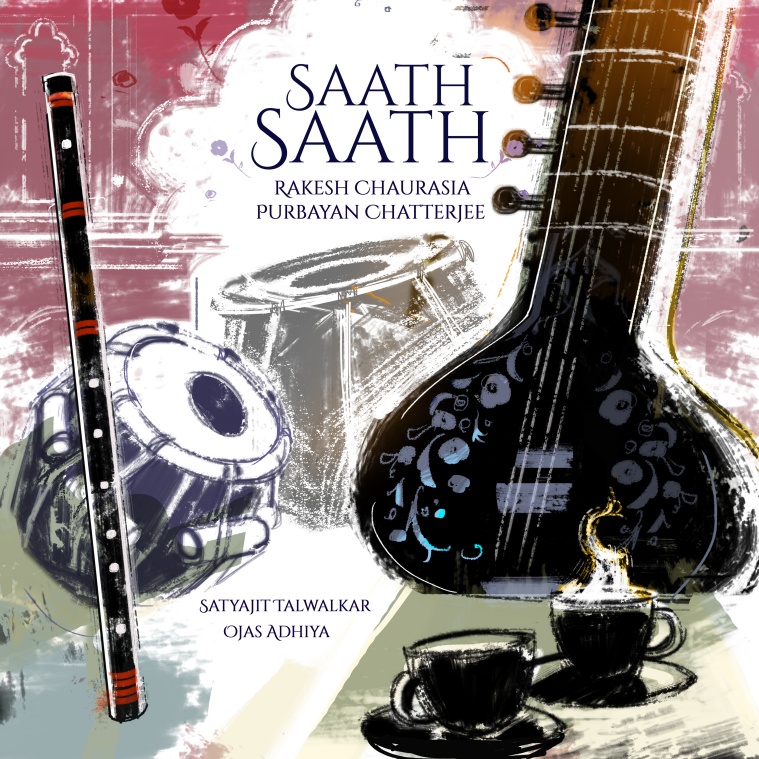
[ad_1]
Album: Saath Saath
Artiste: Purbayan Chatterjee and Rakesh Chaurasia with Satyajit Talwalkar and Ojas Adhiya
Rating: Three and a half stars
It’s been a few years since one heard a full-fledged instrumental album comprising unadulterated Indian classical music. I’m speaking of the kind that is without any frills and flounces, one that comes without the burden of integration with other forms of music – a norm these days to make the age-old Indian chamber music more accessible and agreeable. Full disclosure: If done well, I am all for contemporary classical blends. But in the present times, dominated by populist demands, those occurrences are few and far between. Then there is the kind where an artiste contorts her ego and musical choices to appeal to a music label’s vexatious demands.
For very long, good music has argued to exist. But with a digital world, it doesn’t have to. Online streaming is giving enough opportunity and platforms to musicians to create music on their own terms and not care about the market forces, which for a couple of decades, have massively interfered with music, its making, and the money an artiste deserves.
So when sitar player Purbayan Chatterjee and flautist Rakesh Chaurasia’s seven-track album Saath Saath, comprising seven bandishes in six ragas that complete the time cycle of the morning to night – rises like a phoenix from this dust, it feels like the creation of an optimistic space, building on the music and life lessons imparted by their gurus to create an unadulterated album with two musicians playing instruments that have very different origins and differences. But played together, it has two friends and musicians finding each other musically.
 Saath Saath album cover.
Saath Saath album cover.
What’s also significant is that this album is an ode to sitar legend Nikhil Banerjee (one third of the trio comprising Pt Ravi Shankar and Ut Vilayat Khan), who taught Chatterjee’s father, who then taught the baaj to him. Banerjee learned from Ut Alauddin Khan, the founder of Maihar gharana and Pt Ravi Shankar’s guru but built a style that was his, one that was calmer than that of Shankar’s but as intricate.
While sitar, a traditional classical string instrument, that rests its idea of beauty on meend (an articulation technique that glides the notes to create a continuum effect) has been associated with the world of ragas for centuries, the humble bamboo flute, a wind instrument in which the continuum of notes depends on one’s breath, is a folk instrument brought to the classical fold by Rakesh’s uncle, Pt Hariprasad Chaurasia.
The album journeys through the full cycle of a day through the ragas in accordance with their time and colour. It opens with Lalit, the gentle and serene morning raga, on the flute, creating the imagery of dusk through a simple reed. One of the strongest pieces on the album. Chatterjee supports here with gentle strokes on the sitar. The breaths from Chaurasia can be heard, not removed from the piece, making it as organic as it can be. This is followed by Shuddh Sarang, the majestic day raga, where in the rush to attempt virtuosity, notes falter, especially towards the end. I wish Chatterjee could have done a retake here. A special mention to the magic of the tabla by Satyajit Talwalkar, whose lithe precision stands out. Madhuvanti is a flute piece but while Rakesh never staggers, the bandish does not manage to go deeper. Yaman follows in madhya laya, and the way Chatterjee opens it with a full sound is magnificent. At 16 minutes, this duet, puts out the soul of the raga in its entirety, with a delightful bandish. They complete the piece in the next track – Yaman Drut. The jhala leaves its boundaries often when played on the sitar, while Chaurasia manages to stay committed. Pahadi, which originated as a Kashmiri folk melody, opens on the flute, on which it usually sounds sublime. Chatterjee opens wonderfully too and attempts some noteworthy glides here. Like is tradition, Bhairavi, the heptatonic evening raga concludes the album. Like Lalit, both the artistes are brilliant in this one, deftly weaving a tapestry that speaks not just of the brilliant music but also of the kinship between the two. It concludes with an ethereal and evocative end, capturing this raga of separation created by Wajid Ali Shah. Listen to it for the notes that feel true and explore the expansive world of the ragas.
[adinserter block=”4″]
[ad_2]
Source link